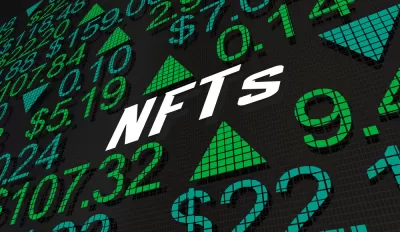With non-fungible tokens (NFTs) reshaping the art and collectibles world, city and regional planners can learn valuable lessons about ways to improve the management, organization, and sharing of information about the built environment.

You may have noticed that people have been going crazy over something called non-fungible tokens—NFTs. From the $69 million sale of contemporary artist Beeple's latest jpeg, to clips from famous videos of football plays replacing trading cards, to Jack Dorsey's first Tweet going on the auction block for $2.9 million, the digital economy has suddenly found a way to monetize unique digital products as collectibles. Like any other trends threatening to upend society, this one will also impact urban planning.
First, let me offer some definitions. Money in the form of cash bills is fungible—it can be easily converted from one denomination to another. A single $100 bill is worth the same as just about any other. But non-fungible items are one-of-a-kind; they cannot be easily swapped and exchanged for set dollar amounts. If you need to clear out a closet or attic, you take all those old dishes inherited from your great aunt, outgrown kids toys, and your college CD collection and put it outside in a yard sale. Each item has special qualities and may sell for cash or may get recycled or donated. These items are all non-fungible.
Today, you can have the same yard sale for all of your digital junk: old photos from camp, videos of Europe, spreadsheet files you used to estimate mortgage payments. Just like with a yard sale, it's very likely that no one wants your digital refuse, but anything that might have value can now be minted into a non-fungible token and registered on the Ethereum blockchain. Ethereum is one of many blockchains, distributed ledgers that are housed on tens of thousands of computers across the planet, where every transaction is recorded and publicly available. This blockchain is the same innovative system that Bitcoin is based upon. Like a county registry of deeds, this Ethereum blockchain records the ownership and sale price of every NFT transaction—except without any centralized government authority (for a accessible guide to converting any digital item to an NFT, check out Kevin Roose's recent column in The New York Times, which itself was later auctioned off for half a million dollars).
Here we come back to the implications for planning. While planners are known for their keen aesthetic tastes, NFTs aren't critically important for planners because of contemporary art or baseball e-cards. Rather, NFTs represent a sea change in how knowledge and intellectual property is managed, catalogued, and recorded. This matters a tremendous amount to planners because the local and regional planning function will need to shift to respond to the blockchain and NFTs.
The current methods employed by local and regional planning authorities to track and manage information now appear to be obsolete. Land records, property taxation, zoning and other regulatory requirements, and demographics—all of these databases rely on massive investments of resources to collect, maintain, and archive. Blockchain technology and the use of NFTs to demonstrate ownership can be used to better track and manage property ownership and organize taxation, as early adopters like Dubai have already seen. Through distributed networks, the onus will no longer be on government agencies to control this information but rather to just tap into it for the purposes of planning. While official records today connote a high level of security and confidence, much of the information stored in these records is highly inaccessible to the public and could be better stored on blockchains, where governments can validate and confirm the information through the minting of NFTs. The United Nations has been experimenting with some of these approaches in helping to manage land records in Afghanistan, while other agencies have utilized blockchains to improve sanitation and waste management in pilot projects across the planet.
While governments have no particular role or involvement in NFTs, they can benefit greatly from this kind of technology. Planning agencies can embrace NFTs as they seek new and creative ways to serve the public. In the face of constant pressure to improve efficiency and equitably address community needs, planners ought to begin to migrate their own information systems into blockchains and mint critical data that can be used to support sound planning around housing, land use, development, regulatory, environmental, historic, and cultural resources. There is no longer a reason that a pdf of a historic inventory needs to be hidden deep in a city website, that report can now be minted as an NFT and recorded in a massive, distributed ledger available across the globe, and for free. The recording of the report can permanently link it to the places its inventory covered, to offer an archived geocoding of historic knowledge that can always be used to ensure planning for a just, equitable, and fair future.
Justin B. Hollander, PhD, FAICP, is a professor in the Department of Urban and Environmental Policy and Planning at Tufts University and the author of the first NFT urban planning book Essays on City Planning: Volume I.

Alabama: Trump Terminates Settlements for Black Communities Harmed By Raw Sewage
Trump deemed the landmark civil rights agreement “illegal DEI and environmental justice policy.”

Planetizen Federal Action Tracker
A weekly monitor of how Trump’s orders and actions are impacting planners and planning in America.

The 120 Year Old Tiny Home Villages That Sheltered San Francisco’s Earthquake Refugees
More than a century ago, San Francisco mobilized to house thousands of residents displaced by the 1906 earthquake. Could their strategy offer a model for the present?

Oregon Legislature to Consider Transit Funding Laws
One proposal would increase the state’s payroll tax by .08% to fund transit agencies and expand service.

Housing Vouchers as a Key Piece of Houston’s Housing Strategy
The Houston Housing Authority supports 19,000 households through the housing voucher program.

Rural Population Grew Again in 2024
Americans continued to move to smaller towns and cities, resulting in a fourth straight year of growth in rural areas.
Urban Design for Planners 1: Software Tools
This six-course series explores essential urban design concepts using open source software and equips planners with the tools they need to participate fully in the urban design process.
Planning for Universal Design
Learn the tools for implementing Universal Design in planning regulations.
Clanton & Associates, Inc.
Jessamine County Fiscal Court
Institute for Housing and Urban Development Studies (IHS)
City of Grandview
Harvard GSD Executive Education
Toledo-Lucas County Plan Commissions
Salt Lake City
NYU Wagner Graduate School of Public Service





























